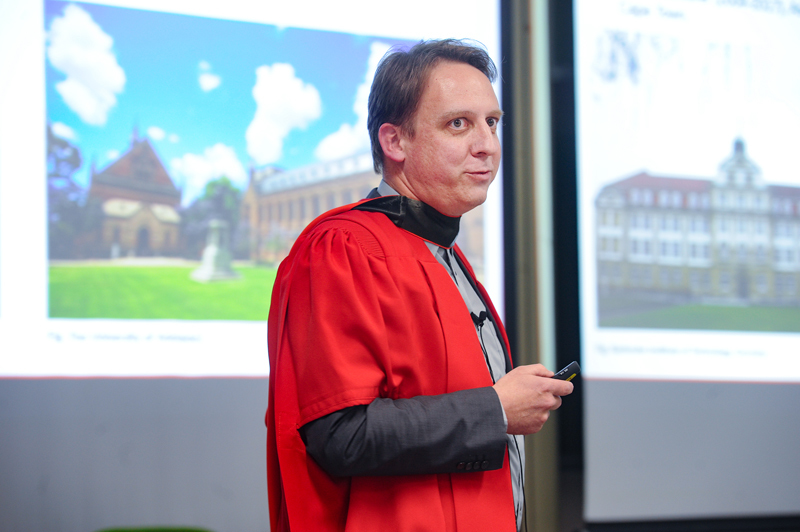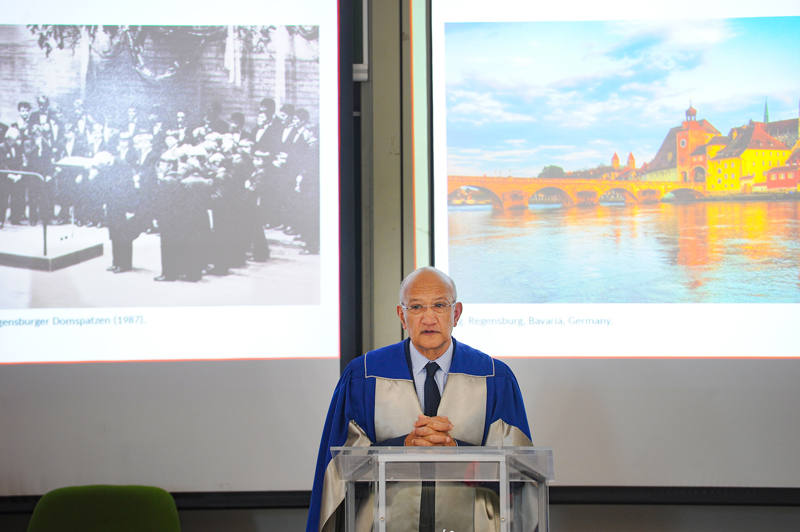Structural mechanics meet rheumatic heart disease and climate change
26 September 2023 | Story Kamva Somdyala. Photos Lerato Maduna. Read time 4 min.
Professor Sebastian Skatulla threaded a scholarly needle by weaving structural mechanics, heart disease and climate change during his inaugural lecture at the University of Cape Town’s (UCT) Snape Building on 13 September.
It’s not that his research work doesn’t “build structures”, as one colleague once asked him, it is that Professor Skatulla sees structural mechanics as a discipline of civil engineering and considers the effect of forces on structures in terms of inducing motion, deformation, damage, and fracture.
Skatulla is a senior lecturer for Structural Engineering and Mechanics in UCT’s Faculty of Engineering & the Built Environment (EBE).
As such, he titled his talk, “What has structural mechanics to do with rheumatic heart disease and global climate change?”
To unpack this, Skatulla undergirded two themes: prevention and treatment of rheumatic heart disease and [a] prediction of global climate change and sea level rise due to the retreat of Antarctic ice shelves.

“Rheumatic heart disease focus is critical in the sub-Saharan region because it is the leading cause of cardiovascular diseases. It is quite preventable if one has access to sufficient healthcare, which is why if you have a throat infection which lasts a long time, best you don’t take it lightly,” Skatulla said.
This is so because some of the bacteria can inflame the heart, and once that happens, the heart takes permanent damage – in particular, the valve leaflets, which can become permanently crippled.
“The heart is not passively filling up when blood is entering.”
“While it’s typically the domain of clinical research, using mechanics, you can provide an additional angle to it. Typically, you take a magnetic resonance imaging (MRI) scan of the heart, which tells you quite a bit in terms of the shell/shape: whether it has enlarged or how its pumping performance is,” Skatulla explained.
In other words, the force response drives the remodelling [of the heart] that cannot be determined by clinical means but can be determined by means of computational modelling.
“In terms of the internal force response, there is a stress response that can be tested. How much is the heart tissue internally stressed? The only problem is that the heart is a complex model, and it sits inside a person’s chest, so one can’t just cut open a person and test.”
He added: “There are several equations to be considered, including Newton’s law of the balanced force equilibrium … but also the underlying mathematical equations driving, for example, the remodelling. You also must account for the electrophysiology because the heart is not passively filling up when blood is entering, but the heart is also actively contracting.”
Filling pressure
What’s more, one needs to set up a patient-specific model, which means you need to get an anatomical computer model of the heart, which you get from MRI scans.
“You also need to know what the filling pressure is, and what drives the filling of the heart. So, additionally, it is essential to calibrate your heart model,” Skatulla said.
The professor then shifted his focus to the other bespoke side of his study, which included a trip to Antarctica to research whether ice has nutrients or energy. It was a collaborative trip which, upon arrival at the margin of the sea ice, was sufficient for them to collect samples.
They could also observe the breakup of the ice during certain times of the year.
![Professor Sebastian Skatulla-348]](/images/userfiles/images/news/2023/2023-09-22_Professor-Sebastian-Skatulla-348.jpg)
Where does Skatulla fit in, in this type of research?
“For the breakup of the ice, you want to be able to describe, mathematically, the damage mechanics. To do the modelling, as in any computational model, you need input, so you need not only get a genetic representation of the ice flow layout, but you also need to get the physical properties, which is the temperature because ice is obviously temperature dependent,” he explained.
“And now coming to the aspect of how this research is linked to global climate change … The sea ice is an important player regulating energy and heat you take from the sun ... so how quickly and how early it breaks up in spring and summer essentially determines how much sunlight in winter is reflected and if the ice cover, due to global warming, is getting less or more.”
 This work is licensed under a Creative Commons Attribution-NoDerivatives 4.0 International License.
This work is licensed under a Creative Commons Attribution-NoDerivatives 4.0 International License.
Please view the republishing articles page for more information.


































































































































































































































































































































































































































